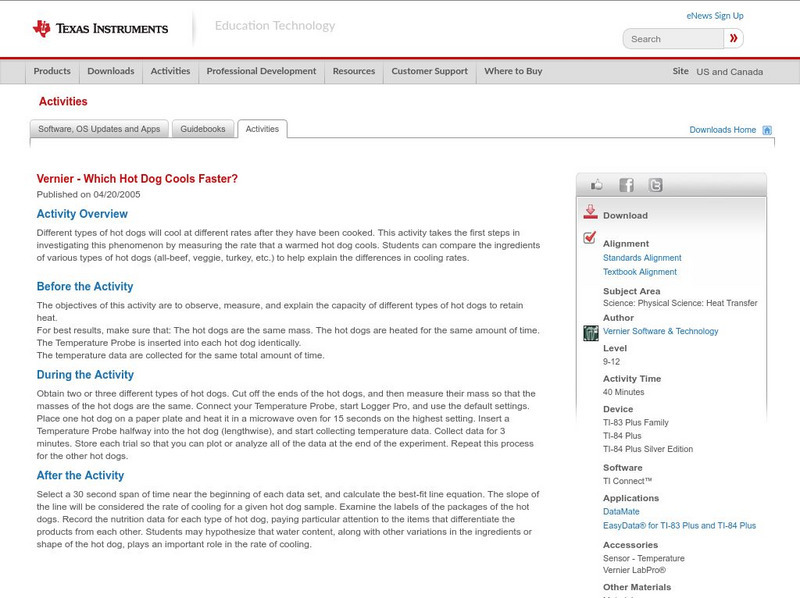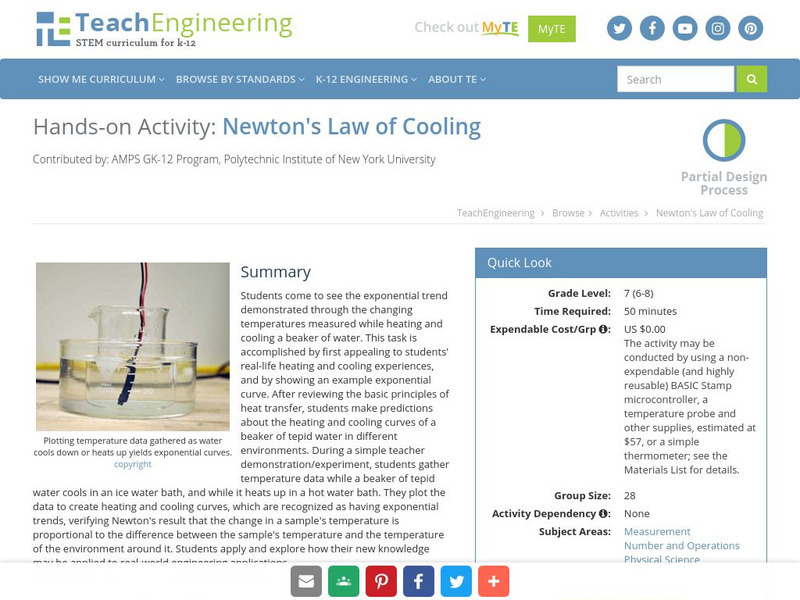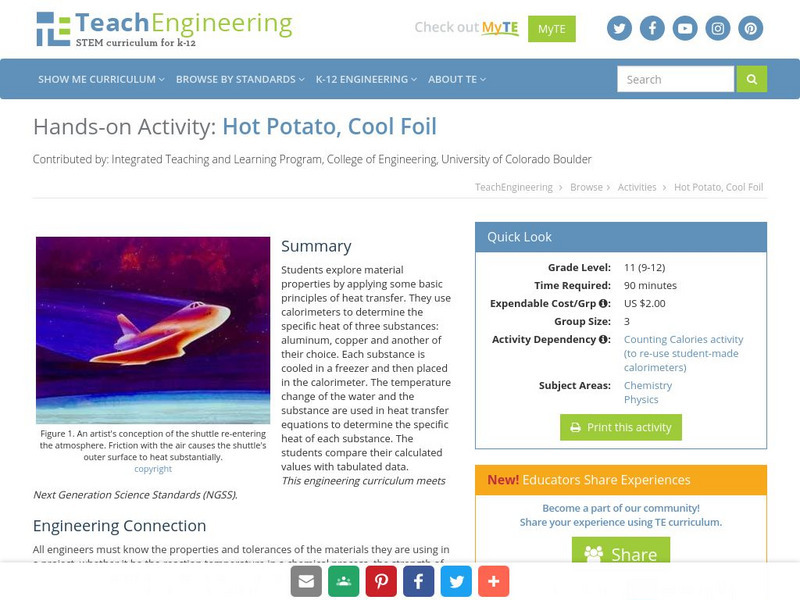Curated OER
Phases
In this phases worksheet, students rank the chemical compounds by decreasing vapor pressure. Students use a phase diagram to determine if water undergoes any phase transitions during the four steps described. This worksheet has 8...
Curated OER
Passive Voice
In this passive voice worksheet, students fill in the blanks to the sentences with the verbs given in the passive voice. Students complete 3 passages.
Curated OER
Liquid Crystal IR Detector
Middle schoolers experiment with one method of detecting infrared radiation. They simulate the detection of infrared radiation using a liquid crystal sheet.
Curated OER
Environment
Learners examine the energy saving benefits of trees. They identify ways in which trees reduce air pollution. They also work together to solve problems related to pollution.
Curated OER
Colored Clouds
Fourth graders, in groups, examine how particles in warm water move faster than particles in cold water.
Curated OER
Coal Ash Analysis
Students use ash contnet, one of the important environmental concerns, that can be determined by massing the residue remaining after buring a sample of coal under controlled conditions. They complete a lab making ash content. Students...
Curated OER
Pronunciation of Regular Past Tense Verbs
In this pronunciation worksheet, students learn how to pronounce a long list of regular past tense verbs. The list is broken into 3 sections based on the sound of the past tense verb ending: /t/, /d/, or/id/.
Curated OER
Hydrologic Cycle
In this science worksheet, students examine the hydrological cycle through the coloring of the picture that graphically organizes the concept.
Curated OER
Living in the Desert: Reading Comprehension
In this comprehension learning exercise, students read a short selection about sand gazelles, then answer 5 multiple choice questions. Answers provided.
Curated OER
Bicycle Pump Pressure
Students explain that air pressure applies a force. If any of students have flown in an airplane, they have felt the "popping" of their ears caused by the change in atmospheric pressure because of the altitude changes.
Curated OER
Transformation of E. coli with Antibiotic Resistance
Students participate in an experiment in which they transform an E. coli cell. They discover how the genetic make-up of the cell can be changed by added foreign DNA. They answer questions to complete the lab.
Curated OER
Here Comes the Rain
Second graders help to prepare a model of the water cycle before the conduction of this experiment. They use the model in order to observe changes that happen to water when it changes states of matter.
Curated OER
Rocks Word Search Puzzle
In this literacy activity, students look for the words that are related to the concept that is reviewed in the sheet. They also acquire new vocabulary.
ArtsNow
Arts Now Learning: Dance With Heating, Cooling, and Insulation [Pdf]
In this lesson, 3rd graders use movement and dance composition to aid their comprehension of heating, cooling, and insulation.
Khan Academy
Khan Academy: Biology: Specific Heat, Heat of Vaporization, and Density of Water
Why does ice float? In this article answer that question by learning about the topics of Specific heat capacity, evaporative cooling, and heat of vaporization of water.
Science Buddies
Science Buddies: Just Keep Cool How Evaporation Affects Heating and Cooling
When we get hot, we sweat. The physiological role of sweat is to cool us down. When the water evaporates, it removes energy from our bodies. This sort of evaporative cooling can also be used to cool homes, using what are referred to as...
Other
King County Court House: Heating & Cooling Curves [Pdf]
This page is a lab that will teach you about heating and cooling curves.
Texas Instruments
Texas Instruments: Which Hot Dog Cools Faster?
Different types of hot dogs will cool at different rates after they have been cooked. This activity takes the first steps in investigating this phenomenon by measuring the rate that a warmed hot dog cools. Students can compare the...
TeachEngineering
Teach Engineering: Newton's Law of Cooling
Students come to see the exponential trend demonstrated through the changing temperatures measured while heating and cooling a beaker of water. This task is accomplished by first appealing to students' real-life heating and cooling...
TeachEngineering
Teach Engineering: Hot Potato, Cool Foil
Students explore material properties by applying some basic principles of heat transfer. They use calorimeters to determine the specific heat of three substances: aluminum, copper and another of their choice. Each substance is cooled in...
American Chemical Society
Middle School Chemistry: Temperature and Density
Observe how heating and cooling affect the density of water. Combine the concepts of temperature, molecular motion, and density to learn that hot water is less dense than room temperature water and that cold water is more dense.
TeachEngineering
Teach Engineering: What's Hot and What's Not?
With the help of simple, teacher-led demonstration activities, young scholars learn the basic physics of heat transfer by means of conduction, convection, and radiation. They also learn about examples of heating and cooling devices, from...
American Chemical Society
Middle School Chemistry: The Ups and Downs of Thermometers
Based on experimental observations, young scholars describe, on the molecular level, why the liquid in a thermometer goes up when it is heated and down when it is cooled.
TeachEngineering
Teach Engineering: Conduction, Convection, and Radiation
With the help of simple, teacher-led demonstration activities, students learn the basic concepts of heat transfer by means of conduction, convection, and radiation. Students then apply these concepts as they work in teams to solve two...
Other popular searches
- Heating and Cooling
- Heating and Cooling Curves
- Science Heating and Cooling
- Heating and Cooling Curve
- Heating and Cooling Energy
- Heating and Cooling Systems
- Milk Heating and Cooling
- Heating and Cooling Water
- +Heating and Cooling













![Arts Now Learning: Dance With Heating, Cooling, and Insulation [Pdf] Lesson Plan Arts Now Learning: Dance With Heating, Cooling, and Insulation [Pdf] Lesson Plan](https://static.lp.lexp.cloud/images/attachment_defaults/resource/large/FPO-knovation.png)






